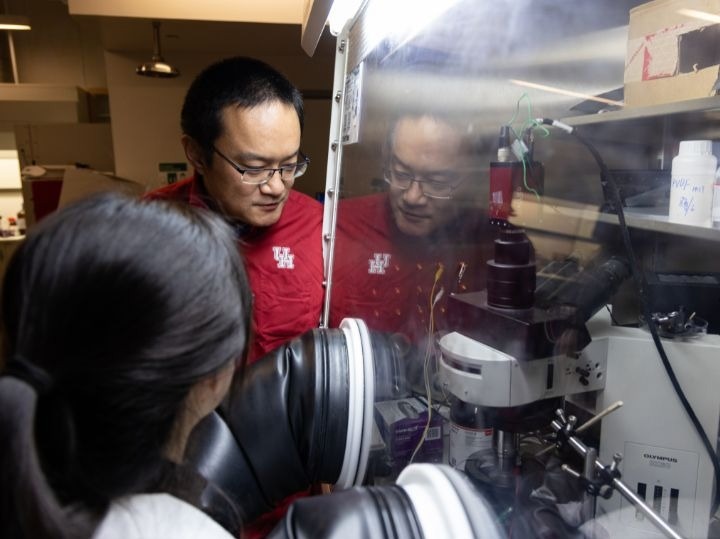In daily human life, lithium-ion batteries have shown great transformation. Nearly everyone has a smartphone and more electric vehicles could be spotted on the roads, and they keep power generators going in times of emergencies.
 As Professor Xiaonan Shan observes, UH graduate Guangxia Feng works on the operando reflection interference microscope (RIM) inside a “glove box” because the lithium-ion battery electrolyte is flammable. Image Credit: University of Houston.
As Professor Xiaonan Shan observes, UH graduate Guangxia Feng works on the operando reflection interference microscope (RIM) inside a “glove box” because the lithium-ion battery electrolyte is flammable. Image Credit: University of Houston.
The need for greater energy-density batteries that are safe and inexpensive is growing as highly portable electric vehicles, electronic devices, and large-scale grid implementations have become commonplace.
Currently, a research group from the University of Houston, in collaboration with scientists from the Pacific Northwest National Laboratory and the US Army Research Laboratory, has come up with an operando reflection interference microscope (RIM) that offers a better insight into batteries work, consisting of considerable implications for the batteries’ next generation.
We have achieved real-time visualization of solid electrolyte interphase (SEI) dynamics for the first time. This provides key insight into the rational design of interphases, a battery component that has been the least understood and most challenging barrier to developing electrolytes for future batteries.
Xiaonan Shan, Study Corresponding Author and Assistant Professor, Electrical and Computer Engineering, Cullen College of Engineering, University of Houston
The study has been reported in the Nature Nanotechnology journal.
The highly sensitive microscope enables scientists to study the SEI layer, which is a fragile and extremely thin layer on the battery electrode surface, identifying the performance of the battery. Its morphology and chemical composition are constantly altering, making it difficult to study.
“A dynamic, non-invasive, and high sensitivity operando imaging tool is required to understand the formation and evolution of SEI. Such a technique capable of direct probing SEI has been rare and highly desirable,” stated Yan Yao, the Hugh Roy and Lillie Cranz Cullen Distinguished Professor of electrical and computer engineering and a co-corresponding author who has collaborated with Shan on this project for the past four years.
“We have now demonstrated that RIM is the first of its kind to provide critical insight into the working mechanism of the SEI layer and help design better high-performance batteries,” stated Yao, who is also the principal investigator of the Texas Center for Superconductivity at UH.
How it Works
The research group employed the principle of interference reflection microscopy in the project, where the light beam—centering at 600 nm with a spectrum width of nearly 10 nm—was led towards the electrodes and SEI layers and then reflected.
The gathered optical intensity consists of interference signals between different layers, carrying significant data regarding the evolution process of SEI and enabling the scientists to witness the complete reaction process.
“The RIM is very sensitive to surface variations, which enables us to monitor the same location with large-scale high spatial and temporal resolution,” stated UH graduate student Guangxia Feng, who executed the majority of the experimental work on the project.
The scientists note that most battery scientists at present make use of cryo-electron microscopes, which have the potential to take one picture at a certain time and cannot constantly track the shifts at the same location.
I wanted to approach energy research from a different angle by adapting and developing new characterization and imaging methods which provide new information to understand the reaction mechanism in energy conversion processes.
Xiaonan Shan, Study Corresponding Author and Assistant Professor, Electrical and Computer Engineering, Cullen College of Engineering, University of Houston
Shan specializes in crafting spectrometry techniques and imaging methods to study electrochemical reactions in energy storage and conversions. Also, this new imaging method could be employed in other advanced energy storage systems.
Feng, who earned a Ph.D. in electrical engineering from UH in 2022, comments:
“To realize the next generation of batteries, it is essential to understand the reaction mechanisms and novel materials. I have always wanted to be a scientist because they can make great things happen for people and change the world for the better."
Wu Xu from Pacific Northwest National Lab, an expert in electrolyte designs, assisted with the project design and offered crucial knowledge on the electrolyte to use. Kang Xu, an expert in SEI research at the Army Research Lab, offered considerable knowledge to help comprehend the phenomenon that has been noted. Both authors are the co-corresponding authors for the study.
The lead authors of the study are Feng and another UH engineering student Yaping Shi, together with Hao Jia from PNNL. The other contributors are Xu Yan, Yanliang Liang, Chaojie Yang, and Ye Zhang from UH; Mark Engelhard at PNNL.
Journal Reference:
Feng, G., et al. (2023) Imaging solid–electrolyte interphase dynamics using operando reflection interference microscopy. Nature Nanotechnology. doi.org/10.1038/s41565-023-01316-3.